Recycling is an important solution for addressing climate change, because producing new products from recovered materials requires fewer raw resources and less energy. According to Project Drawdown, recycling can reduce at least 10 gigaton of CO2 by 2050. However, sorting out recyclables isn’t an easy job, which is why over 50% of recyclables still end up in the landfill. This is an area ripe for automation that has a huge environmental impact.
Robots that can sort recyclables aren’t a new concept - they’ve been in operations since 2017, pioneered by companies like AMP Robotics and MAX AI. However, when Areeb called up a few recycling facilities in 2018, he found that those facilities were still using humans to sort recyclables. Those robots were simply too expensive. With this in mind, he started Glacier with a goal of bringing down the complexity and cost of recyclables sorting. Today, their robots are 60% more affordable than competitors, equal in performance, and each deployed machine can prevent CO2 emissions equivalent to taking 400 cars off the road.
Where are all the recycling robots?
Back in 2018, Areeb was a software engineer at Facebook. He had worked on a wide range of products from enterprise ads to marketplace and had acquired a patent along the way. He knew though it was time to explore something new. He knew he wanted to work on climate. But what to tackle? He started his quest with his strengths in mind: something at the intersection of software and AI.
He looked into several different solution areas such as EV and solar, but the most attractive fields were the long-established ones like recycling. Its repetitive tasks were ripe for automation. To conduct his due diligence, he reached out to Recology through his network as well as cold called recycling facilities to learn about this space. He heard the same complaints over and over again: sorting recyclables is hard, labor is hard to come by, and the sorting quality is bad.
This surprised Areeb. Why not use the recycling robots already in the market offered by the likes of AMP and MAX AI? After digging further, he understood the math doesn’t work out - the robots are too expensive. To be more specific, the all-in cost of a human sorter (considering base salary, benefits, training, uniforms, etc.) is around $100k a year. If they were to invest in a recycling robot, they need a payback period of two years or less. This means the total cost of the robot can’t exceed $200k. The cost of a recycling robot was way beyond this threshold.
With that price point in mind, Areeb looked at feasibility: is a sorting robot possible at a price tag of $200k? Assuming ≥ 70% margin, the BOM (bill of materials, or total cost) of the machine has to be lower than $60k. Both AMP and MAX AI use a delta robot (see pictures below), which at the time costs $40k by itself. In other words, the key to a cheaper recycling solution is to find a cheaper robot. Hard, but not impossible. Staking his future on this bet, he quit his job and started Glacier with a mission to bring down the cost of recycling.
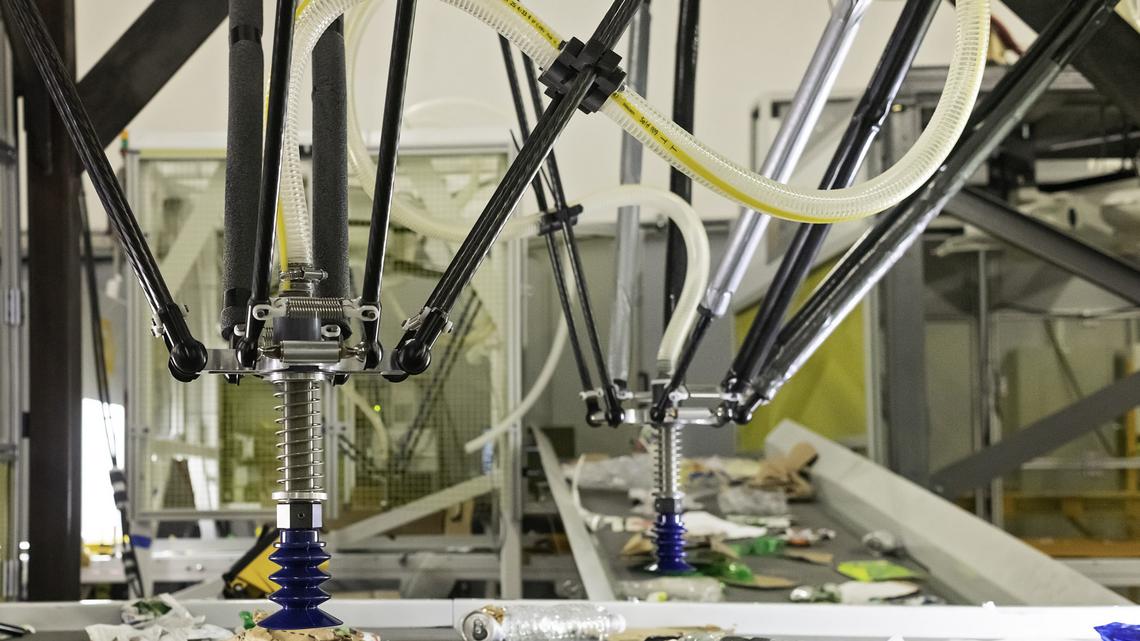 Delta robot used by AMP Robotics.
Delta robot used by AMP Robotics.
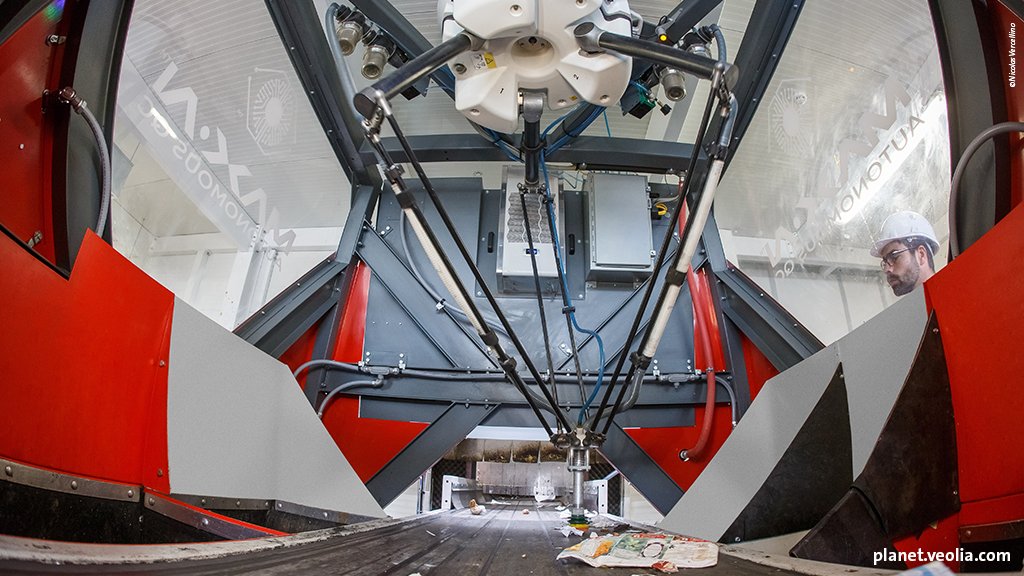 Delta robot used by MAX AI.
Delta robot used by MAX AI.
Initial design: Minimize the cost by minimizing degrees-of-freedom
The main cost driver in a robot is often the hardware. Areeb realized early-on he had to focus on making the hardware as simple and manufacturable as possible. The key component in a recycling robot is the actuation mechanism that moves the end effector at the end of the robot to be in contact with the recyclables on the conveyor belt. The big problem in recycling is: how can you design the simplest mechanism to pick up as many recyclables as possible as they pass by on the conveyor belt? After some research, Areeb found this is equivalent to minimizing the number of degrees-of-freedom (DOF).
In case you are not familiar with this concept: DOF is a characterization of the directions of motions a rigid body can do. To achieve every pose possible in a reachable space, you need 6DOF (3 linear, 3 rotational). For a robot, the number of DOF is usually determined by the types of joints - a prismatic joint has 1 DOF which is a linear movement, while a revolute joint has 1 DOF which is a rotational movement in a fixed dimension. The more joints it has, the more degrees of freedom it gets.
The delta robot used by incumbents technically offers 4DOF, but the rotational DOF is unused because the end effector is a suction cup. If you rotate a suction cup, then nothing changes, it’s still a suction cup. Next he looked at the translational DOF. Areeb realized the conveyor already offers one degree of freedom as it’s always moving in one direction. With 2 redundant DOF, a recycling robot really only needs 2 DOF: one to move across the belt (y) and one to move up and down (z) to pick up objects (The two green axes in the diagram below.)
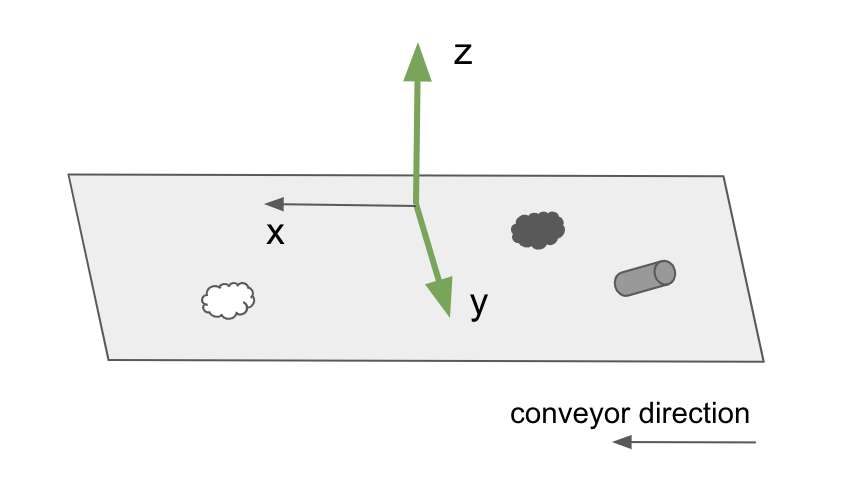 Illustration of the 3 translational DOFs considered. Conveyor is moving in the x direction. The 2 green axes, y and z, are selected.
Illustration of the 3 translational DOFs considered. Conveyor is moving in the x direction. The 2 green axes, y and z, are selected.
There were two potential 2DOF systems: a parallel robot (also known as “2 DOF delta robot”) and a cartesian system. The former was relatively new and just beginning to show up on the market, while the latter had been used in the industry for 20-25 years. With that longevity, the cartesian system was well tested and was easy to find cheap off-the-shelf systems available with high Mean-Time-Between-Failure, a key metric for measuring robustness. Low price and high reliability was exactly what Areeb was looking for. A cartesian system it is.
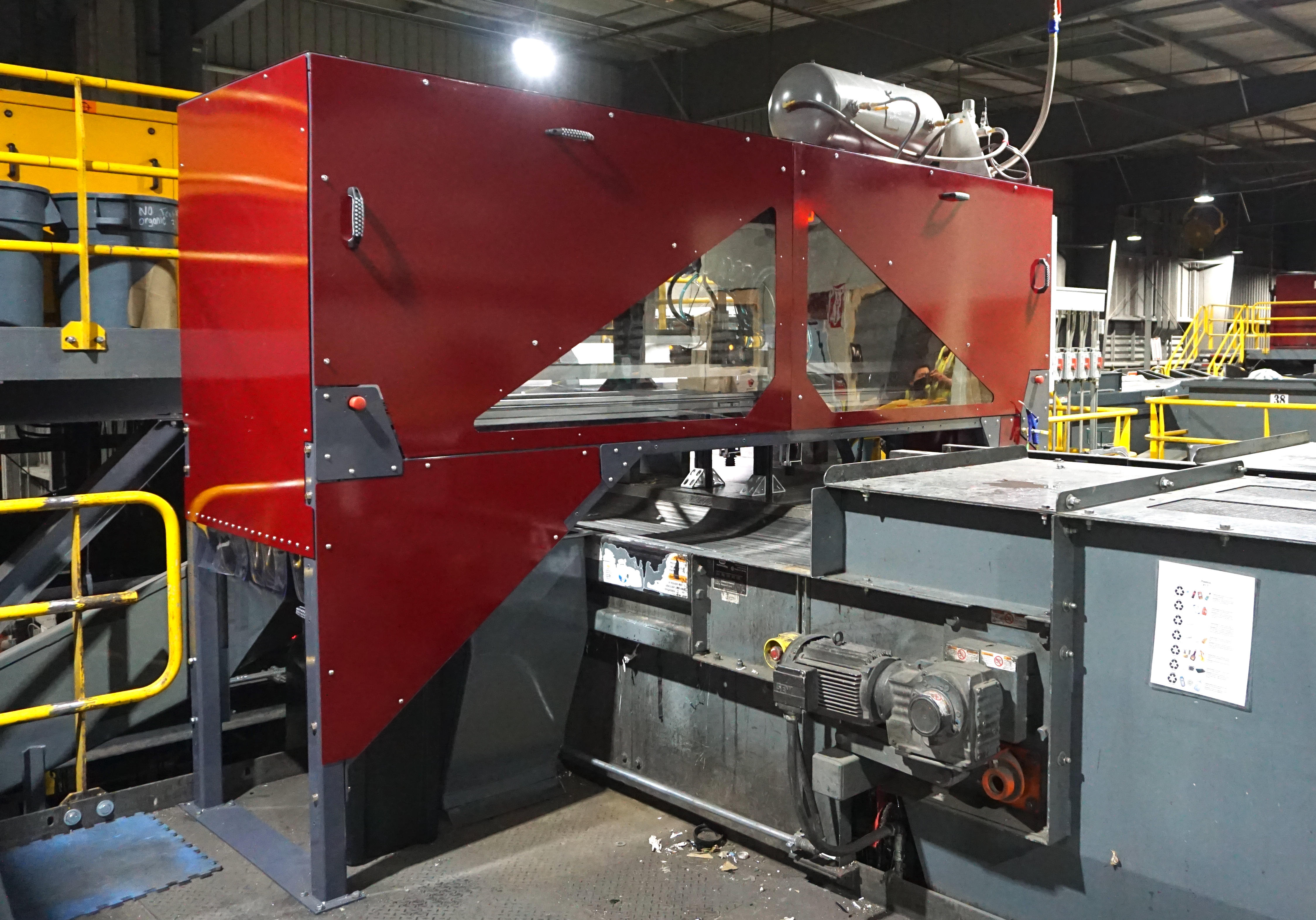 Glacier's robotic system in a recycling facility.
Glacier's robotic system in a recycling facility.
Lean engineering: Making the right trade-offs
Building the first hardware prototype is always hard. Even harder, Glacier was attempting to solve an active area of research: grabbing heterogeneous items. Throughout the prototyping process, his team lived (and still lives!) the principle of lean engineering - build the minimum viable product in the least amount of time in order to get customer feedback as early as possible.
To minimize prototyping time, the hardware team and the software team maintain a close relationship. The strategy used by the team is: assume the worst performance of the other team and assume the prototype will only work 80% of the time. This encourages both the hardware team and the software team to search for the best wins inside their own domain and bake them into early implementations, thereby reducing future iterations. Knowing the performance boundary within hardware and software also helps define the architecture much more easily. For hardware, this means they need a suction cup that picks up objects well, even if the software doesn’t predict the object location exactly correctly. For software, this means they need an algorithm that tracks objects beyond a certain accuracy threshold defined by the suction cup specs.
The lean engineering principle that Areeb’s team follows exemplifies an important learning for robotics startups. Technically, you can solve every problem with bespoke hardware, but the customization cost and lead time are both well beyond reach for early-stage startups. For most tasks, making the software slightly smarter (in this case, a better tracking algorithm) enables the team to build something cheaper and faster.

The climate tech space: massive opportunities, not enough companies
When asked what advice he has for fellow entrepreneurs, Areeb surprisingly said there should be more competitors: “The waste management space is huge, but the number of companies innovating in this space can be counted with a single hand. The space is so massive - there’s room for multiple unicorns.” Beyond waste management, he invites entrepreneurs to look into sectors that make up the backbone of our society that impact climate like transportation and electric grids. The ideas may not sound cool, but their impact is huge, making them great business opportunities.
Another key tip: be open to new ideas. At Glacier, even after they’ve started working on the first idea, the recycling robot, they were “constantly bombarded with big new ideas”. One new idea was that there’s not enough data at the city or brand level about where the trash goes. For example, Coca Cola has no idea where the coke bottles go after they are sold. More object tracking data will facilitate better decision making at both the government level and at the brand level for designing their goods or managing their supply chain for sustainability. Since the recycling robots serve as a key decision point in the recycling workflow, Glacier is taking on this opportunity to develop object tracking technologies with AI.
For engineers and researchers interested in joining climate tech, Areeb has simple advice: “Do it!” He understands that this is a relatively new field and it might feel risky to make the move, but “it’s important to triple down on that feeling to start working on climate”, he says, “the clock is ticking and we don’t have that much time left.”
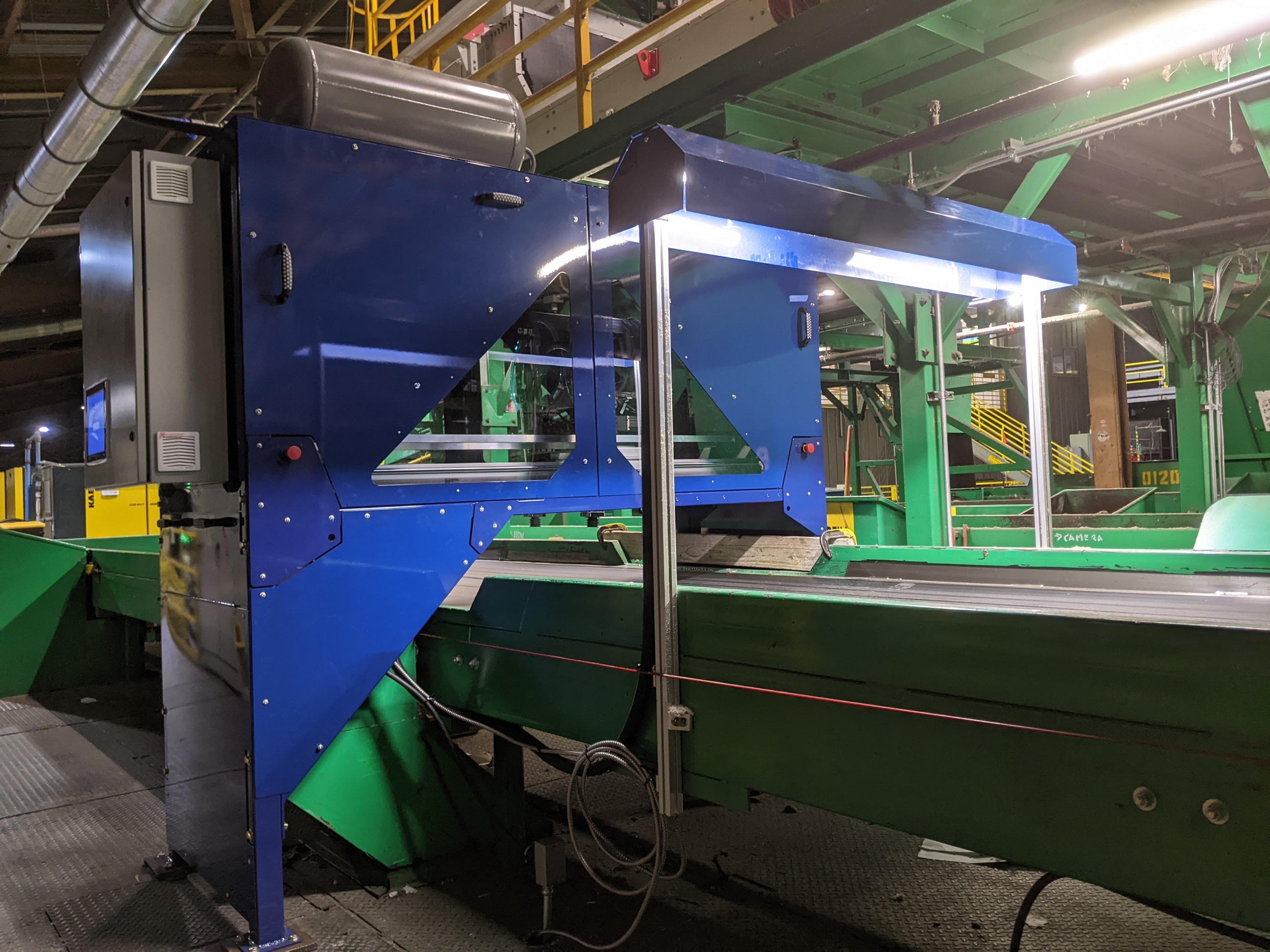 Another Glacier robot in a recycling facility.
Another Glacier robot in a recycling facility.
The Takeaways
Here are our key takeaways from Areeb’s story:
First, for engineering leaders: to make your product cheaper and simpler, break down the problem, apply first principles, and make the right hardware-software trade-offs.
Second, for prospective entrepreneurs: The climate tech market is massive but there’s not enough companies building differentiated solutions for all customers. If you see an incumbent, don’t be scared away. Areeb shows us how to challenge the status quo robotics solutions by being open to customer needs and applying analytical thinking.
Third, for engineers and researchers itching to join climate tech: Do it!
If you are interested in getting involved in climate robotics, we hope you find these takeaways helpful! Don’t forget to like this article at the bottom!
If you are interested in Glacier, they are actively hiring. You can reach out on their website here or reach out to Areeb directly at areeb@endwaste.io.
This is the second article in our Founder Spotlight series. Check out our other blogs here. Do you know a cool company or person actively working on climate robots? Let us know!
Acknowledgement
Thanks Robert Eng for helping with editing!